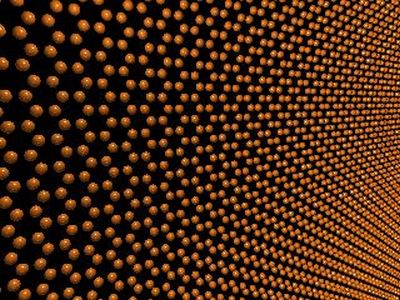Two Faculty Members Organize ICERM Program on Point Configurations
 This honeycomb crystal structure is the energy minimizing configuration for a class of isotropic pair potentials obtained via inverse optimization techniques. (Courtesy Salvatore Torquato, Princeton University)
This honeycomb crystal structure is the energy minimizing configuration for a class of isotropic pair potentials obtained via inverse optimization techniques. (Courtesy Salvatore Torquato, Princeton University)Professors Ed Saff and Doug Hardin are spending the spring semester at the Institute for Computational and Experimental Research in Mathematics (ICERM) at Brown University, where they are organizing a Semester Program on Point Configurations in Geometry, Physics, and Computer Science. Saff is the director of the program committee, and Hardin is a co-organizer of the program. The two have worked and published extensively together on the mathematics of point configurations.
The arrangement of point configurations in metric spaces is an interdisciplinary topic of significant interest in mathematics, physics, and computer science. Mathematical aspects involve optimization, discretization of manifolds, best packing, and cubature, among others. In physics, such configurations arise in the study of crystallization, random processes, self-assembling materials, jammed states, and phase transitions. In computer science, extremal point configurations play a fundamental role in coding and information theory, and lattice-based protocols in cryptography and related computational complexity issues are of growing importance.
Research in these areas increasingly involves both mathematics and computational techniques. The development of new efficient computational methods enables more extensive numerical experiments, Saff explains. These experiments, in turn, suggest conjectures that become the focus of rigorous theorem proving, which may also require some computer assistance.
This dynamic makes the subject well-suited to the mission of ICERM, which is to support and broaden the relationship between mathematics and computation.
The program is organized into four workshops: Optimal and Random Point Configurations; Fast Algorithms for Generating Static and Dynamically Changing Point Configurations; Computation and Optimization of Energy, Packing, and Covering; and Computational Challenges in the Theory of Lattices.
In addition to Hardin and Saff, several other mathematicians active in the research of point configurations and related topics are also on the program’s organizing committee. They are Christine Bachoc of the University of Bordeaux, France; Henry Cohn, with Microsoft Research New England; Peter Grabner of Graz University of Technology, Austria; Achill Schermann of the University of Rostock, Germany; Sylvia Serfaty of the Universit Pierre et Marie Curie – Paris 6 and the Courant Institute; and Salvatore Torquato of Princeton University.
Three other members of the Vanderbilt Department of Mathematics are also participating in the program: Assistant Professor Widen Kusner and graduate students Ahram Feigenbaum and Oleksandr Vlasiuk.
This program involves participants not only from different scientific fields, says Saff, but even within mathematics, it’s fostering connections between such diverse areas as geometry, number theory, combinatorics, approximation theory, optimization, and potential theory. We hope these interactions will lead to significant progress in the study and application of point configurations.
More information about the program is available on the ICERM website.